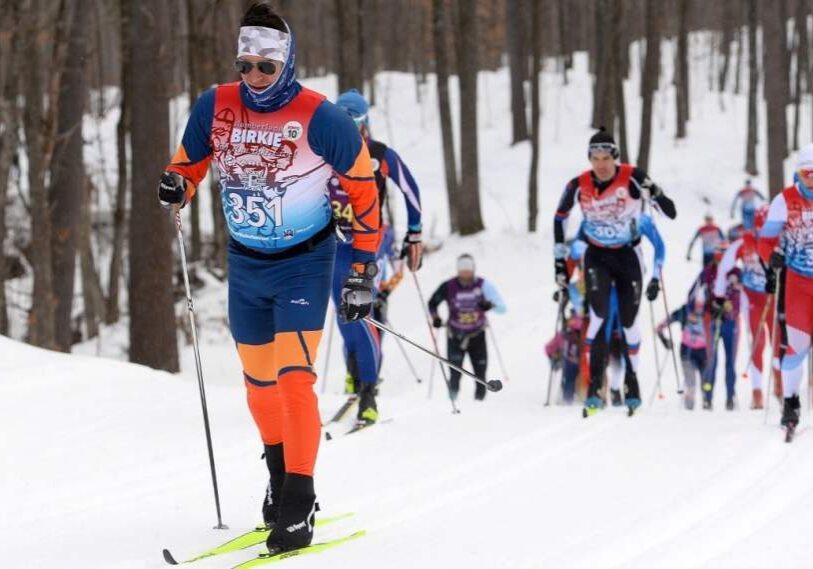Paddling the Mississippi River is a Grand Adventure!
Friends group passing by Southeast Minnesota shores in October

UPPER MISSISSIPPI RIVER—Observing autumn colors, migratory birds, and a winding-down barge season are among the many attractions seen on the Upper Mississippi at this time of year – paddlers making their way from the headwaters to the ocean, not so much.
The Mississippi River stretches for around 2,400 miles from central Minnesota to the Gulf of Mexico. Every year, 30 to 50 paddlers attempt to travel its length.
Shawn Hamerlinck made the journey by kayak earlier this year. A teacher had planted the idea for the trip in his mind years ago, as a way to see ecosystems along the length of the Mississippi River.
He started on May 24, 2025 and paddled, on average, 12 to 14 hours per day.
For him, the undertaking was personal. Others who do it have science or education or advocacy on their minds.

Five friends – from left to right, David Collison, Coby Bassin, Trevor Dralle, Charles Lampman, and Morgan Skinner – gathered at Lake Itasca to begin their paddle down the Mississippi River. They are doing citizen science, education and fundraising along the way. (Photo courtesy of Morgan Skinner)
Five friends took off from Lake Itasca, the river’s headwaters, on September 1, 2025. They are traveling under the banner of the Drift South Expedition and are doing citizen science, education and fundraising along the way.
Whatever the motivation, it’s sure to be an adventure.
“The Mississippi is an iconic river. When anyone thinks of the United States, they think of the Mississippi because it has such a long, long history,” said John Sullivan, who paddled it in 2013 and runs a Facebook support group for other paddlers. “And it’s kind of a wilderness.”
Connection to nature
The river starts as a small stream flowing out of northern Minnesota’s Lake Itasca. In its early stretches, Hamerlinck said, the water is pristine.
“You can see what you believe to be five feet down, and it’s actually 45 feet down. You can see giant fish – northern pike – and the water is so clear, so clean, and so beautiful that you could just take a cup and drink it,” said Hamerlinck.
As he traveled downstream this summer and the river became more industrialized, things changed drastically.
He had to be careful to avoid barges, and he couldn’t drink the water anymore. There was trash in it and unappetizing white foam. Near St. Louis, he said he was almost afraid to light a match because of what looked like gasoline floating on the river.
“You see steel and iron still sitting on the side, rusting away, and you ask, ‘Why did we do that?’” said Hamerlinck.
“It makes you look at the environment and say, ‘We should have taken better care of you. And I’m sorry. And we shall do better than what you see.’”
Even so, he says he experienced plenty of wonder. Encounters with wildlife – at times very intimate – were a highlight of the trip.
A skunk sprayed him, nesting geese bit him, invasive carp hit him in the face, and he came across a black bear floating in the river.
His scariest encounters were with alligators as he headed south.
“The big alligators will swim about 20 yards from you, parallel to you, and they’ll stay right next to you for about half a mile,” said Hamerlinck. “What they’re trying to do is figure out who’s bigger – you in the kayak, or them.”
He slept in a tent or, when he could not find any dry land, on his kayak. In addition to animal encounters, he says storms, difficult conditions, and the monotony of daily miles can wear on a paddler.
“The biggest challenge, hands down, is not the animals or the storms or the distance. It’s the human mind,” said Hamerlinck.

Shawn Hamerlinck on his kayak during his 2025 journey down the Mississippi. On the side are some of the signatures of the 119 people he met along the way. (Photo courtesy of Shawn Hamerlinck)
Still, for him, disconnecting from electronics and the connection to nature made it all worth it.
“The best part of it was the sandbars that you would sit on,” he said. “I would stop there about half an hour before sunset . . . you just stop, and you just look around you, and see that there is nature right next to you. It’s not like when you go to a zoo.”
Paddling with a purpose
The Drift South Expedition, which pushed off on September 1, will be passing along the shores of Minnesota’s Winona and Houston counties sometime in October. According to the group’s online updates, they were in the Twin Cities the first week in October.
“There are so many kind people in the world. From people who cook delicious meals, to letting us sleep on their living room floor, to giving us soup and fish to heat up, there has been so much kindness,” stated one recent post.
Their trek through Minnesota has connected them with lots of wildlife. “(We’ve) never seen so many birds in one area . . . eight bald eagles one day, 10 great blue herons another. So graceful and pretty,” according to their blog.
The Drift South Expedition came together when five friends who’d all backpacked the Appalachian Trail started thinking about another adventure to try.
One of them had been wanting to paddle the Mississippi River since he was 13 years old, and the others quickly signed on. But they wanted to do more than paddle.
“What can we do on this expedition to be able to help us, but also help the community, the scientific community, the people who depend on the Mississippi River?” asked Charles Lampman.

Members of the Drift South Expedition pause during their southward journey through Minnesota to scan the vastness of the Upper Mississippi River backwaters. (Drift South Expedition photo)
Lampman says he’s lost opportunities to work in conservation due to recent budget cuts, but he didn’t want to stop that work entirely.
“And that’s when we landed on this idea of, well, we can do scientific research and we can advocate for science and show people that citizen science is possible,” he said.
One goal is to test water quality every 25 miles – and then every 50 miles, they’ll sample for microplastics. They are working with a couple of post-doctoral researchers at Saint Louis University to process this data, which will eventually be publicly available.
Their journey is also an opportunity to fund raise and educate people about the river. When they pull through cities, they set up educational materials on their canoes and try to engage curious passersby about how microplastics can move throughout the ecosystem and other issues.
“Whenever we have this opportunity to slow down and engage with people, I think we’re all okay with taking a little bit more time if that means some more authentic connections,” Lampman said.
Support leads to success
The five-person Drift South Expedition is traveling with two canoes and a kayak, working together to log the necessary miles and meet their advocacy goals.
On the eve of their departure, while putting the finishing touches on their rigs, they were also checking in with each other.

Two canoes and a kayak are ‘home’ for members of the Drift South Expedition paddling the entire length of the Mississippi River in the autumn of 2025. (Drift South Expedition photo)
“We’ve all sat down and been like, ‘Okay, how is everyone feeling? What does everyone need from each other? How can we help?’” said Morgan Skinner.
“That teamwork and the team aspect of it was something that initially really attracted me to the project,” David Collison said.
Paddling hundreds or thousands of miles can be daunting, even with a team.
John Sullivan, who completed the full length of the Mississippi in 2013, said, “I had a goal of trying to paddle all the state-named rivers that flow to the Mississippi, and I’ve done them all except the Arkansas – that one remains on my bucket list.”
He founded the Facebook group Mississippi River Paddlers more than a decade ago as a way to support other paddlers’ journeys.
“I saw a lot of value in being able to communicate and reach out to other people who’ve done the river, and ask questions if they run into a problem,” Sullivan said.
Sullivan keeps an informal list of paddlers. He says that in the past 12 years, several hundred people have paddled segments of the river. Around 100 to 200 paddlers have completed the trip from Lake Itasca to the Gulf of Mexico.
Hamerlinck, meanwhile, said he weathered broken paddles, cracks in his kayak, and disembarked 33 pounds lighter by the time he was done. Sometimes days passed without him seeing any people. When he did meet someone, he asked them to sign his kayak so they could accompany him for the rest of the journey.
“If you look at the boat, it’s got signatures from every person I met along the way, and it’s packed full,” said Hamerlinck. He counted 119 signatures on his boat, and some of those people, he said, “tracked me all the way down.”
Hamerlinck finished his 2025 journey in Burns Point, Louisiana on July 17, 55 days after launching. The Drift South Expedition is taking its time and still weeks away from completing its 2000+ mile trip. If you travel along the Mississippi this October, keep your eyes open – you might just see them!
Learn more about the Drift South Expedition crew members and their progress from the Twin Cities to Winona and Houston counties on the Drift South Expedition website or Facebook page.

This story is a product of the Mississippi River Basin Ag & Water Desk, an independent reporting network based at the University of Missouri in partnership with Report for America, with major funding from the Walton Family Foundation.
Story edited for Root River Current by John Gaddo.






